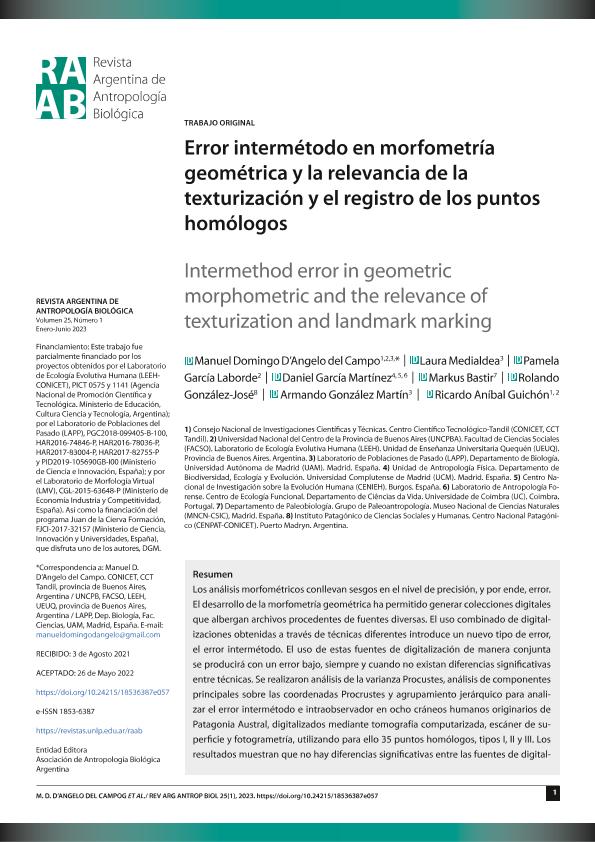Mostrar el registro sencillo del ítem
dc.contributor.author
D'angelo del Campo, Manuel Domingo

dc.contributor.author
Medialdea, Laura
dc.contributor.author
Garcia Laborde, Pamela

dc.contributor.author
Garcia Martinez, Daniel
dc.contributor.author
Bastir, Markus

dc.contributor.author
Gonzalez-Jose, Rolando

dc.contributor.author
González Martín, Armando
dc.contributor.author
Guichon, Ricardo Anibal

dc.date.available
2023-09-20T12:51:51Z
dc.date.issued
2023-01
dc.identifier.citation
D'angelo del Campo, Manuel Domingo; Medialdea, Laura; Garcia Laborde, Pamela; Garcia Martinez, Daniel; Bastir, Markus; et al.; Error intermétodo en morfometría geométrica y la relevancia de la texturización y el registro de los puntos homólogos; Asociacion Argentina de Antropologia Biológica; Revista Argentina de Antropología Biológica; 25; 1; 1-2023; 1-18
dc.identifier.issn
1853-6387
dc.identifier.uri
http://hdl.handle.net/11336/212245
dc.description.abstract
Los análisis morfométricos conllevan sesgos en el nivel de precisión, y por ende, error.El desarrollo de la morfometría geométrica ha permitido generar colecciones digitalesque albergan archivos procedentes de fuentes diversas. El uso combinado de digital-izaciones obtenidas a través de técnicas diferentes introduce un nuevo tipo de error,el error intermétodo. El uso de estas fuentes de digitalización de manera conjuntase producirá con un error bajo, siempre y cuando no existan diferencias significativas entre técnicas. Se realizaron análisis de la varianza Procustes, análisis de componentesprincipales sobre las coordenadas Procrustes y agrupamiento jerárquico para anali-zar el error intermétodo e intraobservador en ocho cráneos humanos originarios dePatagonia Austral, digitalizados mediante tomografía computarizada, escáner de su-perficie y fotogrametría, utilizando para ello 35 puntos homólogos, tipos I, II y III. Losresultados muestran que no hay diferencias significativas entre las fuentes de digital ización, pudiéndose utilizar conjuntamente archivos 3D de diversa procedencia. No se observó error intraobservador significativo para ninguna de las fuentes, siendo este de menor magnitud que el error intermétodo. En el presente estudio, la fotogrametría, único método que recupera la textura y en el cual se señalaron previamente los puntos homólogos, es la fuente que presenta el menor error. Sobre la base de los resultados obtenidos se sugiere que es posible realizar análisis de morfometría geométrica satisfactorios independientemente de la fuente utilizada para su registro, considerando las aquí analizadas, destacándose la relevancia de la textura y el registro de los puntos de referencia en el nivel de error.
dc.description.abstract
Morphometric analyses lead to biases in the level of precision, and therefore, error. Geometric morphometrics development has made it possible to create digital collections composed by records from diverse sources. The combined use of data obtained through multiple methods introduces a new type of error, the inter-method error. The joint use of distinct digitization sources will result in low error, as long as there are no significant differences in the results obtained among techniques. An analysis of the Procustes variance, a principal component analysis on the Procrustes coordinates and a hierarchical cluster analysis were carried out to analyse the inter-method and intra-observer error in eight human skulls from Southern Patagonia, digitized by computerized tomography, surface scanner and photogrammetry, using 35 landmarks type I, II and III. The results show that there are no significant differences between the digitization sources, so 3D files from different sources could be used together. No significant intra-observer error was observed for any of the sources, also presenting a lower magnitude than the intermethod error. In the present study, photogrammetry, the only method that permits recovering the texture and in which the landmarks were previously indicated, is the source that presents the lowest error. Based on the results obtained, it is suggested that it is possible to perform satisfactory geometric morphometric analyses regardless of the source used for its registration, considering those analysed here, highlighting the influence of the texture and the registration of landmarks on the degree of error.
dc.format
application/pdf
dc.language.iso
spa
dc.publisher
Asociacion Argentina de Antropologia Biológica
dc.rights
info:eu-repo/semantics/openAccess
dc.rights.uri
https://creativecommons.org/licenses/by-nc-sa/2.5/ar/
dc.subject
BIOANTHROPOLOGY
dc.subject
SOUTHERN PATAGONIA
dc.subject
VIRTUAL ANTHROPOLOGY
dc.subject.classification
Otras Humanidades

dc.subject.classification
Otras Humanidades

dc.subject.classification
HUMANIDADES

dc.title
Error intermétodo en morfometría geométrica y la relevancia de la texturización y el registro de los puntos homólogos
dc.title
Intermethod error in geometric morphometric and the relevance of texturization and landmark marking
dc.type
info:eu-repo/semantics/article
dc.type
info:ar-repo/semantics/artículo
dc.type
info:eu-repo/semantics/publishedVersion
dc.date.updated
2023-09-15T11:50:40Z
dc.journal.volume
25
dc.journal.number
1
dc.journal.pagination
1-18
dc.journal.pais
Argentina

dc.journal.ciudad
La Plata
dc.description.fil
Fil: D'angelo del Campo, Manuel Domingo. Universidad Nacional del Centro de la Provincia de Buenos Aires. Facultad de Ciencias Sociales. Departamento de Arqueología. Laboratorio de Ecología Evolutiva Humana (Sede Quequén); Argentina. Universidad Autónoma de Madrid; España. Consejo Nacional de Investigaciones Científicas y Técnicas. Centro Científico Tecnológico Conicet - Tandil; Argentina
dc.description.fil
Fil: Medialdea, Laura. Universidad Autónoma de Madrid; España
dc.description.fil
Fil: Garcia Laborde, Pamela. Universidad Nacional del Centro de la Provincia de Buenos Aires. Facultad de Ciencias Sociales. Departamento de Arqueología. Laboratorio de Ecología Evolutiva Humana (Sede Quequén); Argentina. Consejo Nacional de Investigaciones Científicas y Técnicas. Centro Científico Tecnológico Conicet - Tandil; Argentina
dc.description.fil
Fil: Garcia Martinez, Daniel. Universidad Complutense de Madrid; España
dc.description.fil
Fil: Bastir, Markus. Consejo Superior de Investigaciones Científicas; España
dc.description.fil
Fil: Gonzalez-Jose, Rolando. Consejo Nacional de Investigaciones Científicas y Técnicas. Centro Científico Tecnológico Conicet - Centro Nacional Patagónico. Instituto Patagónico de Ciencias Sociales y Humanas; Argentina
dc.description.fil
Fil: González Martín, Armando. Universidad Autónoma de Madrid; España
dc.description.fil
Fil: Guichon, Ricardo Anibal. Consejo Nacional de Investigaciones Científicas y Técnicas. Centro Científico Tecnológico Conicet - Tandil; Argentina. Universidad Nacional del Centro de la Provincia de Buenos Aires. Facultad de Ciencias Sociales. Departamento de Arqueología. Laboratorio de Ecología Evolutiva Humana (Sede Quequén); Argentina
dc.journal.title
Revista Argentina de Antropología Biológica
dc.relation.alternativeid
info:eu-repo/semantics/altIdentifier/url/https://revistas.unlp.edu.ar/raab/article/view/12552
dc.relation.alternativeid
info:eu-repo/semantics/altIdentifier/doi/http://dx.doi.org/10.24215/18536387e057
Archivos asociados
